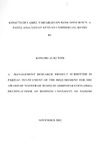| dc.description.abstract | Financial intermediation theory posits that information asymmetry arises in financial
markets between borrowers and lenders because borrowers generally know more
about their investment projects than lenders do. This intermediation function when
carried out efficiently reflects a sound intermediation process and hence the banks’
due contribution to economic growth through offering more affordable banking
services like loans and deposit taking at better interest rate margins.
Our problem statement is informed by the changing structure of the banking industry
that calls for the adoption of a broader based set of performance measures like the
CAMEL framework that go beyond the traditional measurements like Return on
Assets and Return on Equity. Further the impact of the market power and efficiency
theories on whether profitability is determined by bank market power or bank
efficiency also calls for us to go deeper and establish whether, based on market
power, inefficient banks can simply translate their higher costs to higher prices and
still earn positive profits or whether profitability is simply a result of efficiency.
The objective of the study therefore, was to establish the effects of CAMEL variables
on bank Efficiency as measured by the efficiency ratio of Kenyan commercial banks.
The study adopted a panel data design and descriptive approach to meet its objectives.
Annual financial statements of 37 Kenyan commercial banks from 2007 to 2011 were
obtained from the CBK. The data comprising a sample of 185 study units was
analyzed using multiple linear regressions method.
Our findings suggest that Capital Adequacy, Earnings and Liquidity ratio have a
negative relationship to efficiency ratio while Management quality and Asset Quality
have a positive relationship. The policy implication therefore is that, banks and the
regulatory authorities should find an optimal point on regulatory capital adequacy
ratio and liquidity ratio whereby banks would not be holding on too much capital and
liquidity without compromising on their efficiency. Further, the findings also indicate
that banks should strive to be more efficient by managing their asset book well and
invest in credit risk management systems and recruit and pay well, the best human
resource to derive efficiency benefits. | en |

